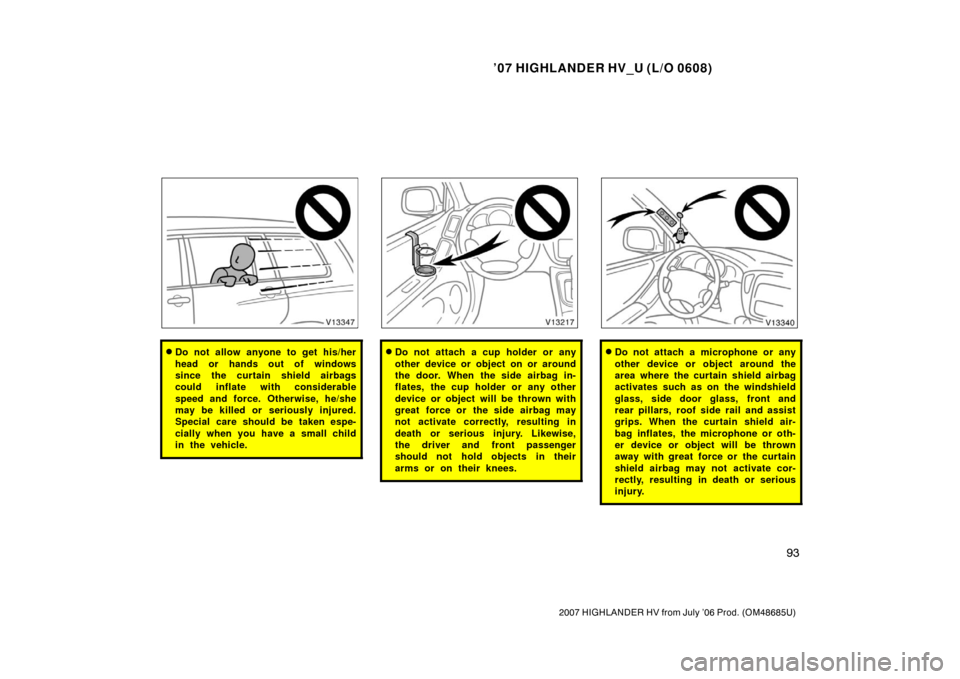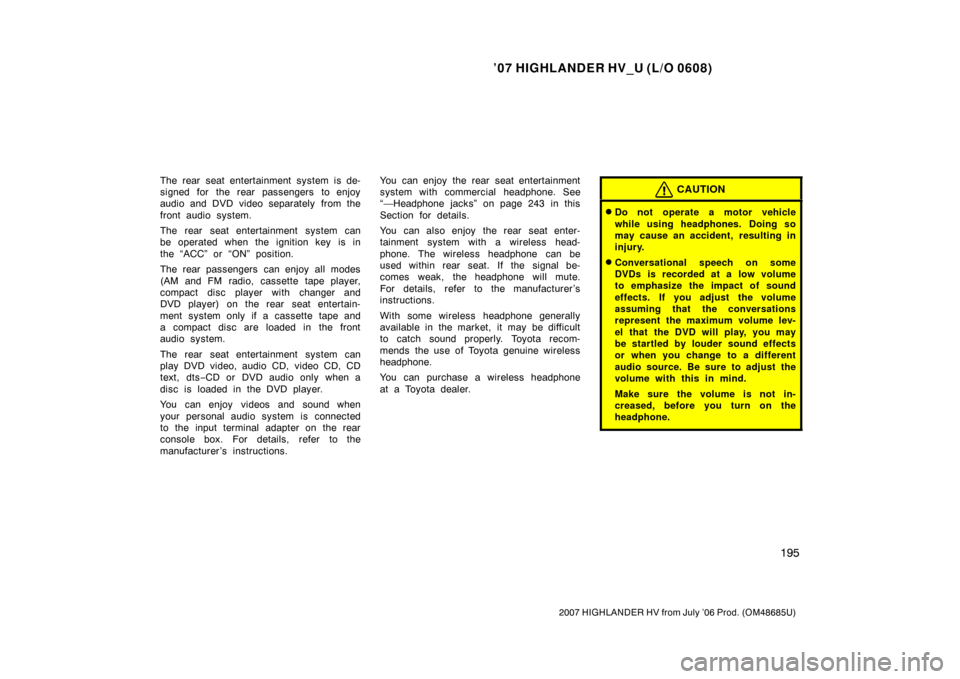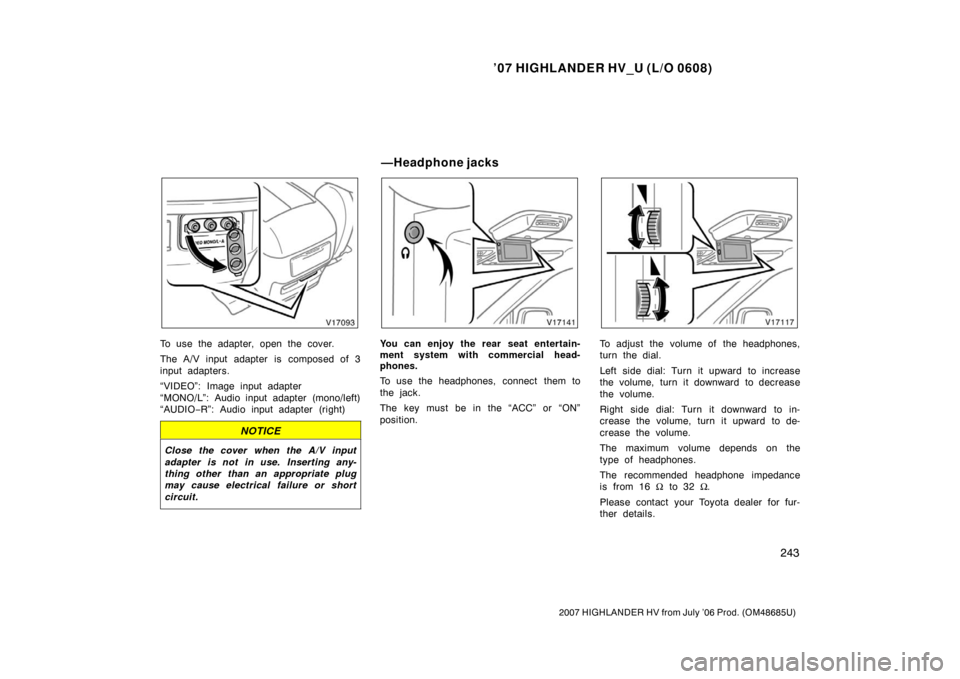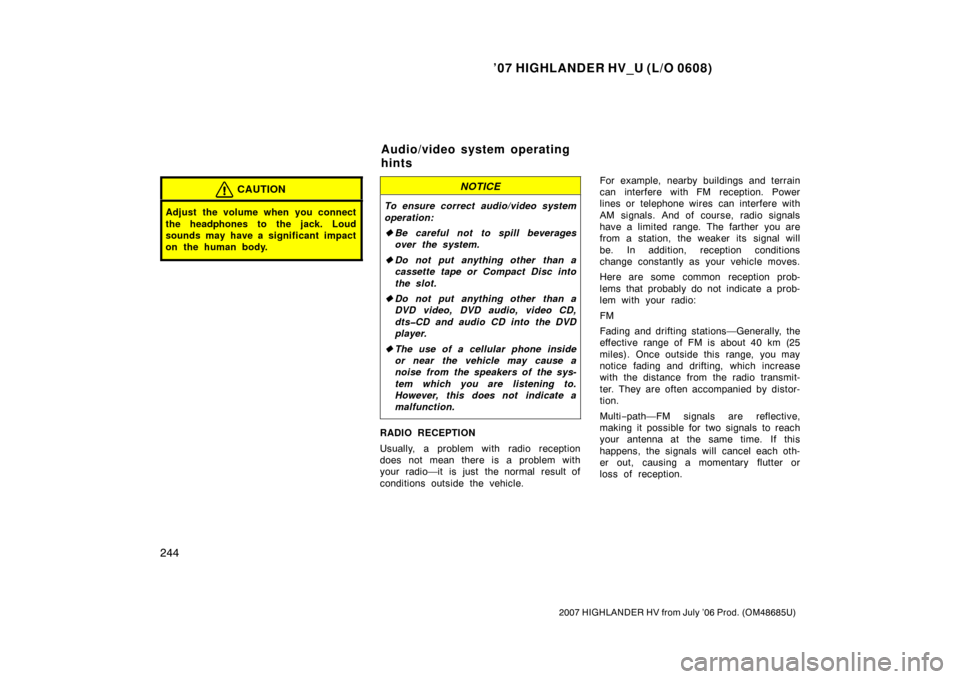Page 105 of 436

’07 HIGHLANDER HV_U (L/O 0608)
93
2007 HIGHLANDER HV from July ’06 Prod. (OM48685U)
�Do not allow anyone to get his/her
head or hands out of windows
since the curtain shield airbags
could inflate with considerable
speed and force. Otherwise, he/she
may be killed or seriously injured.
Special care should be taken espe-
cially when you have a small child
in the vehicle.�Do not attach a cup holder or any
other device or object on or around
the door. When the side airbag in-
flates, the cup holder or any other
device or object will be thrown with
great force or the side airbag may
not activate correctly, resulting in
death or serious injury. Likewise,
the driver and front passenger
should not hold objects in their
arms or on their knees.�Do not attach a microphone or any
other device or object around the
area where the curtain shield airbag
activates such as on the windshield
glass, side door glass, front and
rear pillars, roof side rail and assist
grips. When the curtain shield air-
bag inflates, the microphone or oth-
er device or object will be thrown
away with great force or the curtain
shield airbag may not activate cor-
rectly, resulting in death or serious
injury.
Page 206 of 436
’07 HIGHLANDER HV_U (L/O 0608)
194
2007 HIGHLANDER HV from July ’06 Prod. (OM48685U)
The rear seat entertainment system con-
sists of the following components.1. Headphone volume control dials
2. Headphone jacks
3. DVD player
4. Rear seat entertainment system display
5. Rear seat entertainment system controller
6. Input terminal adapter
7. Power outlet (See “Power outlet” on page 281 in Section 1 −10.)
8. Power outlet main switch
9. Front audio system
Rear seat entertainment system—
Page 207 of 436

’07 HIGHLANDER HV_U (L/O 0608)
195
2007 HIGHLANDER HV from July ’06 Prod. (OM48685U)
The rear seat entertainment system is de-
signed for the rear passengers to enjoy
audio and DVD video separately from the
front audio system.
The rear seat entertainment system can
be operated when the ignition key is in
the “ACC” or “ON” position.
The rear passengers can enjoy all modes
(AM and FM radio, cassette tape player,
compact disc player with changer and
DVD player) on the rear seat entertain-
ment system only if a cassette tape and
a compact disc are loaded in the front
audio system.
The rear seat entertainment system can
play DVD video, audio CD, video CD, CD
text, dts−CD or DVD audio only when a
disc is loaded in the DVD player.
You can enjoy videos and sound when
your personal audio system is connected
to the input terminal adapter on the rear
console box. For details, refer to the
manufacturer ’s instructions. You can enjoy the rear seat entertainment
system with commercial hea
dphone. See
“—Headphone ja cks” on page 243 in this
Section for details.
You can also enjoy the rear seat enter-
tainment system with a wireless head-
phone. The wireless headphone can be
used within rear seat. If the signal be-
comes weak, the headphone will mute.
For details, refer to the manufacturer’s
instructions.
With some wireless headphone generally
available in the market, it may be difficult
to catch sound properly. Toyota recom-
mends the use of Toyota genuine wireless
headphone.
You can purchase a wireless headphone
at a Toyota dealer.CAUTION
�Do not operate a motor vehicle
while using headphones. Doing so
may cause an accident, resulting in
injury.
�Conversational speech on some
DVDs is recorded at a low volume
to emphasize the impact of sound
effects. If you adjust the volume
assuming that the conversations
represent the maximum volume lev-
el that the DVD will play, you may
be startled by louder sound effects
or when you change to a different
audio source. Be sure to adjust the
volume with this in mind.
Make sure the volume is not in-
creased, before you turn on the
headphone.
Page 255 of 436

’07 HIGHLANDER HV_U (L/O 0608)
243
2007 HIGHLANDER HV from July ’06 Prod. (OM48685U)
To use the adapter, open the cover.
The A/V input adapter is composed of 3
input adapters.
“VIDEO”: Image input adapter
“MONO/L”: Audio input adapter (mono/left)
“AUDIO−R”: Audio input adapter (right)
NOTICE
Close the cover when the A/V input
adapter is not in use. Inserting any-
thing other than an appropriate plug
may cause electrical failure or short
circuit.
You can enjoy the rear seat entertain-
ment system with commercial head-
phones.
To use the headphones, connect them to
the jack.
The key must be in the “ACC” or “ON”
position.To adjust the volume of the headphones,
turn the dial.
Left side dial: Turn it upward to increase
the volume, turn it downward to decrease
the volume.
Right side dial: Turn it downward to in-
crease the volume, turn it upward to de-
crease the volume.
The maximum volume depends on the
type of headphones.
The recommended headphone impedance
is from 16 Ω to 32 Ω.
Please contact your Toyota dealer for fur-
ther details.
—Headphone j acks
Page 256 of 436

’07 HIGHLANDER HV_U (L/O 0608)
244
2007 HIGHLANDER HV from July ’06 Prod. (OM48685U)
CAUTION
Adjust the volume when you connect
the headphones to the jack. Loud
sounds may have a significant impact
on the human body.
NOTICE
To ensure correct audio/video system
operation:
�Be careful not to spill beverages
over the system.
� Do not put anything other than a
cassette tape or Compact Disc into
the slot.
� Do not put anything other than a
DVD video, DVD audio, video CD,
dts�CD and audio CD into the DVD
player.
� The use of a cellular phone inside
or near the vehicle may cause a
noise from the speakers of the sys-
tem which you are listening to.
However, this does not indicate a
malfunction.
RADIO RECEPTION
Usually, a problem with radio reception
does not mean there is a problem with
your radio—it is just the normal result of
conditions outside the vehicle. For example, nearby buildings and terrain
can interfere with FM reception. Power
lines or telephone wires can interfere with
AM signals. And of course, radio signals
have a limited range. The farther you are
from a station, the weaker its signal will
be. In addition, reception conditions
change constantly as your vehicle moves.
Here are some common reception prob-
lems that probably do not indicate a prob-
lem with your radio:
FM
Fading and drifting stations—Generally, the
effective range of FM is about 40 km (25
miles). Once outside this range, you may
notice fading and drifting, which increase
with the distance from the radio transmit-
ter. They are often accompanied by distor-
tion.
Multi
−path—FM signals are reflective,
making it possible for two signals to reach
your antenna at the same time. If this
happens, the signals will cancel each oth-
er out, causing a momentary flutter or
loss of reception.
Audio/video system operating
hints